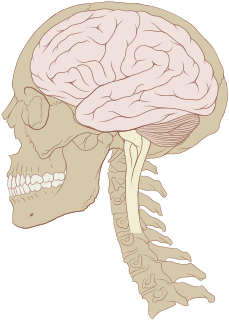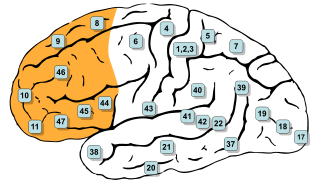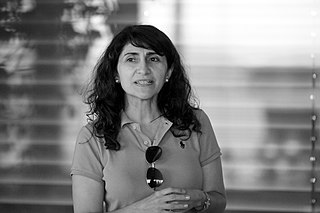Related Research Articles
The following outline is provided as an overview of and topical guide to neuroscience:
Neuropsychology is a branch of psychology that is concerned with how the brain and the rest of the nervous system influence a person's cognition and behaviors. More importantly, professionals in this branch of psychology often focus on how injuries or illnesses of the brain affect cognitive functions and behaviors.

The human brain is the central organ of the human nervous system, and with the spinal cord makes up the central nervous system. The brain consists of the cerebrum, the brainstem and the cerebellum. It controls most of the activities of the body, processing, integrating, and coordinating the information it receives from the sense organs, and making decisions as to the instructions sent to the rest of the body. The brain is contained in, and protected by, the skull bones of the head.

The ventral tegmental area (VTA), also known as the ventral tegmental area of Tsai, or simply ventral tegmentum, is a group of neurons located close to the midline on the floor of the midbrain. The VTA is the origin of the dopaminergic cell bodies of the mesocorticolimbic dopamine system and other dopamine pathways; it is widely implicated in the drug and natural reward circuitry of the brain. The VTA plays an important role in a number of processes, including reward cognition and orgasm, among others, as well as several psychiatric disorders. Neurons in the VTA project to numerous areas of the brain, ranging from the prefrontal cortex to the caudal brainstem and several regions in between.
Idiothetic literally means "self-proposition", and is used in navigation models to describe the use of self-motion cues, rather than allothetic, or external, cues such as landmarks, to determine position and movement. The word is sometimes also spelled "ideothetic". Idiothetic cues include vestibular, optic flow and proprioception. Idiothetic cues are important for the type of navigation known as path integration in which subjects navigate purely using such self-motion cues. This is achieved by an animal through the signals generated by angular and linear accelerations in the course of its exploration. These information generate and update a vector towards the starting point and an accurate path for return.

In mammalian brain anatomy, the prefrontal cortex (PFC) is the cerebral cortex which covers the front part of the frontal lobe. The PFC contains the Brodmann areas BA8, BA9, BA10, BA11, BA12, BA13, BA14, BA24, BA25, BA32, BA44, BA45, BA46, and BA47.
Executive functions are a set of cognitive processes that are necessary for the cognitive control of behavior: selecting and successfully monitoring behaviors that facilitate the attainment of chosen goals. Executive functions include basic cognitive processes such as attentional control, cognitive inhibition, inhibitory control, working memory, and cognitive flexibility. Higher order executive functions require the simultaneous use of multiple basic executive functions and include planning and fluid intelligence.

The orbitofrontal cortex (OFC) is a prefrontal cortex region in the frontal lobes of the brain which is involved in the cognitive process of decision-making. In non-human primates it consists of the association cortex areas Brodmann area 11, 12 and 13; in humans it consists of Brodmann area 10, 11 and 47.

The inferior temporal gyrus is one of three gyri of the temporal lobe and is located below the middle temporal gyrus, connected behind with the inferior occipital gyrus; it also extends around the infero-lateral border on to the inferior surface of the temporal lobe, where it is limited by the inferior sulcus. This region is one of the higher levels of the ventral stream of visual processing, associated with the representation of objects, places, faces, and colors. It may also be involved in face perception, and in the recognition of numbers.
Elizabeth Gould is an American neuroscientist and the Dorman T. Warren Professor of Psychology at Princeton University. She was an early investigator of adult neurogenesis in the hippocampus, a research area that continues to be controversial. In November 2002, Discover magazine listed her as one of the 50 most important women scientists.
Developmental cognitive neuroscience is an interdisciplinary scientific field devoted to understanding psychological processes and their neurological bases in the developing organism. It examines how the mind changes as children grow up, interrelations between that and how the brain is changing, and environmental and biological influences on the developing mind and brain.

The reward system is a group of neural structures responsible for incentive salience, associative learning, and positively-valenced emotions, particularly ones which involve pleasure as a core component. Reward is the attractive and motivational property of a stimulus that induces appetitive behavior, also known as approach behavior, and consummatory behavior. In its description of a rewarding stimulus, a review on reward neuroscience noted, "any stimulus, object, event, activity, or situation that has the potential to make us approach and consume it is by definition a reward". In operant conditioning, rewarding stimuli function as positive reinforcers; however, the converse statement also holds true: positive reinforcers are rewarding.

Patricia Goldman-Rakic was an American professor of neuroscience, neurology, psychiatry and psychology at Yale University School of Medicine. She pioneered multidisciplinary research of the prefrontal cortex and working memory.

Earl Keith Miller is a cognitive neuroscientist whose research focuses on neural mechanisms of cognitive, or executive, control. Earl Miller is the Picower Professor of Neuroscience with the Picower Institute for Learning and Memory and the Department of Brain and Cognitive Sciences at Massachusetts Institute of Technology. He is the Chief Scientist and co-founder of SplitSage. and a co-founder of Neuradia Pharmaceuticals.
The study of memory incorporates research methodologies from neuropsychology, human development and animal testing using a wide range of species. The complex phenomenon of memory is explored by combining evidence from many areas of research. New technologies, experimental methods and animal experimentation have led to an increased understanding of the workings of memory.

Parental experience, as well as changing hormone levels during pregnancy and postpartum, cause changes in the parental brain. Displaying maternal sensitivity towards infant cues, processing those cues and being motivated to engage socially with her infant and attend to the infant's needs in any context could be described as mothering behavior and is regulated by many systems in the maternal brain. Research has shown that hormones such as oxytocin, prolactin, estradiol and progesterone are essential for the onset and the maintenance of maternal behavior in rats, and other mammals as well. Mothering behavior has also been classified within the basic drives. Less is known about the paternal brain, but changes in the father's brain occur alongside the mother once the offspring is born.
William Tallant Greenough was a professor of psychology at the University of Illinois at Urbana–Champaign. Greenough was a pioneer in studies of neural development and brain plasticity. He studied learning and memory and the brain's responses to environmental enrichment, exercise, injury, and aging. He demonstrated that the brain continues to form new synaptic connections between nerve cells throughout life in response to environmental enrichment and learning. This mechanism is fundamental to learning and memory storage in the brain. Greenough is regarded as the predominant researcher in this area and has been described as "one of the towering figures in neuroscience".
Ian Quentin Whishaw is a Canadian neuropsychologist who has contributed extensively to the understanding of cortical organization and its relation to stroke, Parkinson’s, spatial navigation, and behavior. Whishaw is a professor of neuroscience and psychology at the University of Lethbridge and has authored over 460 scientific papers and five books on neuroscience subjects that include a wide range of mammalian species... His interests include varsity football, rugby, basketball, creative writing, and dog and horse training.
Maria Natashini "Natasha" Rajah is a Canadian neuroscientist who is Professor at the Department of Psychiatry, McGill University, and Director of the Douglas Brain Imaging Centre. She is particularly interested in memory, ageing and dementia. Her research uses functional magnetic resonance imaging to establish how biological variables impact the neural networks responsible for memory creation and retrieval.

Bita Moghaddam is an Iranian-American neuroscientist as well as a Professor of Behavioral Neuroscience and the Chair of the Department of Behavioral Neuroscience at Oregon Health and Science University. Moghaddam investigates the neuronal processes underlying emotion and cognition as a first step to designing strategies to treat and prevent brain illnesses.
References
- ↑ "The Great Canadian Psychology Website - Researchers". University of Calgary. Retrieved 14 August 2017.
- ↑ "Profiles - Bryan Kolb". Canadian Institute for Advanced Research. Retrieved 14 August 2017.
- ↑ "Profiles - Bryan Kolb". Canadian Institute for Advanced Research. Retrieved 14 August 2017.
- ↑ "The Great Canadian Psychology Website - Researchers". University of Calgary. Retrieved 14 August 2017.
- ↑ "Fundamentals of Human Neuropsychology - 7th edition". MacMillan Learning. Retrieved 14 August 2017.
- ↑ "Faculty of Arts & Science Neuroscience / CCBN - About US". University of Lethbridge. Retrieved 14 August 2017.
- ↑ "An Introduction to Brain and Behavior, 5th edition". MacMillan Learning. Retrieved 14 August 2017.
- ↑ "MacMillan Learning - Our Authors". MacMillan Learning. Retrieved 14 August 2017.
- ↑ "The nascence of neuroscience in southern Alberta". Canada Foundation for Innovation. Retrieved 14 August 2017.
- ↑ "Six Concordians recognized with Order of Canada". www.concordia.ca. Retrieved 2017-11-08.
- ↑ "Honours - Find a Recipient". The Governor General of Canada. Retrieved 14 August 2017.
- ↑ "The Great Canadian Psychology Website - Researchers". University of Calgary. Retrieved 14 August 2017.
- ↑ "The Great Canadian Psychology Website - Researchers". University of Calgary. Retrieved 14 August 2017.
- ↑ Kolb, B. & Whishaw, I.Q. (2015) Fundamentals of Human Neuropsychology, 7th Edition. New York: Worth-MacMillan.
- ↑ "Profiles - Bryan Kolb". Canadian Institute for Advanced Research. Retrieved 14 August 2017.
- ↑ Leonard, C.M. (1969). The prefrontal cortex of the rat. I. Cortical projection of the mediodorsal nucleus. II. Efferent connections. Brain Research, 12, 321-343
- ↑ Kolb, B. (1984). Functions of the frontal cortex of the rat: A comparative review. Brain Research Reviews, 8, 65-98
- ↑ Uylings, H., Groenewegen, H., & Kolb, B. (2003) Does the rat have a prefrontal cortex? Behavioural Brain Research, 146, 3-17
- ↑ Kolb, B. (1995). Brain plasticity and behavior. Hillsdale, NJ: Lawrence Erlbaum
- ↑ Kolb, B., Mychasiuk, R., Muhammad, A., & Gibb, R. (2013). Brain plasticity in the developing brain. Progress in Brain Research, 207: 35-64.
- ↑ Kolb, B., Gibb, R., Gorny, G. & Whishaw, I.Q. (1998) Possible brain regrowth after cortical lesions in rats. Behavioural Brain Research, 91, 127-141.
- ↑ Monfils, M.-H., Driscoll, I., Kamitakahara, H, Wilson, B., Flynn, C., Teskey, G.C., Kleim, J.A., & Kolb, B. (2006) FGF-2-induced cell proliferation stimulates anatomical, neurophysiological, and functional recovery from neonatal motor cortex injury. European Journal of Neuroscience, 24 ,740-749.
- ↑ Robinson, T.E. & Kolb, B. (2004) Structural plasticity associated with drugs of abuse. Neuropharmacology, 47 Suppl 1, 33-46.
- ↑ "CPA Donald O. Hebb Award for Distinguished Contributions to Psychology as a Science". Canadian Psychological Association. 2019. Retrieved 2019-12-14.
- ↑ Dozois, David J. A. (2018). "Not the years in your life, but the life in your years: Lessons from Canadian psychology on living fully". Canadian Psychology. 59 (2): 107–119. doi:10.1037/cap0000135. ISSN 1878-7304. S2CID 149946085.
- ↑ "Canadian Society for Brain, Behaviour & Cognitive Science: Dr. Bryan Kolb". www.csbbcs.org. Retrieved 2019-12-16.
- ↑ "Honours - Find a Recipient". The Governor General of Canada. Retrieved 14 August 2017.